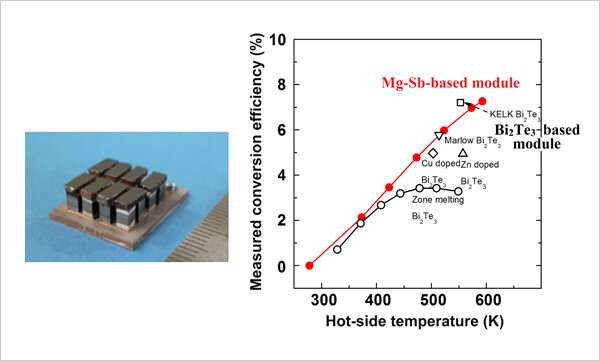Figure. Newly developed module comprised of an Mg3Sb2-based material (left). Its thermoelectric conversion efficiency indicated by the red circles (right). Credit: National Institute for Materials Science
NIMS has succeeded in enhancing the thermoelectric performance of an n-type Mg3Sb2-based material by minutely doping with copper. NIMS and AIST then constructed a module by combining this material with a high-performance p-type material, achieving a conversion efficiency of 7.3% between room temperature and 320°C. This performance is comparable to the best Bi2Te3-based modules, champion for more than a half century. Moreover, the high material performance itself indicates possible efficiency of as high as 11%.
A large proportion of the energy used by humans is dissipated as waste heat. Approximately 90% of this is in the low-temperature range below 320°C. Intensive global efforts are underway to develop thermoelectric materials capable of converting low-temperature waste heat into electricity. Achieving highly efficient thermoelectric conversion requires materials that are simultaneously low in thermal conductivity and high in electrical conductivity. However, developing such materials has been extremely challenging as these two types of conductivity are interrelated. For this reason, Bi2Te3-based materials have reigned as the most efficient in converting low-temperature heat into electricity for over half a century. Because Bi2Te3-based materials contain scarce tellurium as their main component, their practical use in thermoelectric conversion has been very limited. It is therefore highly desirable to develop high-performance thermoelectric materials containing significantly less tellurium.
This research group discovered that the thermoelectric performance of an Mg3Sb2-based material can be enhanced by doping it with a small amount of copper atoms. The enhanced performance was found to occur through two separate mechanisms. First, minute amounts of copper atoms indicated to enter interstitial sites radically scatter phonons—thermal energy carriers—substantially reducing thermal conductivity. Consequently, heat dissipation was greatly reduced, increasing thermoelectric conversion efficiency. Second, copper atoms entering grain boundaries effectively reduced the scattering of electrons. As a result, the electrical mobility of the polycrystalline material—normally not as good electrical conductors—increased to a level equivalent to the electrical mobility of single-crystalline materials. The increased electrical conductivity reduced energy loss caused by Joule heating. These two mechanisms simultaneously reduced the thermal conductivity and increased the electrical conductivity of the Mg3Sb2-based material, thereby increasing its thermoelectric conversion efficiency.
Our results may promote practical and widespread use of thermoelectric modules containing only small amounts of scarce elements to recover waste heat, leading to significant energy conservation. In addition, such modules may be used to develop stand-alone power sources for various types of sensors, which will be needed in very large quantities to realize Japan's Society 5.0 vision. Finally, new ways of altering phonon scattering behavior and controlling grain boundaries were discovered in this project which may be applicable to enhancing the performance of a wide range of other thermoelectric materials.
This research was published in the online version of Joule.
More information: Zihang Liu et al, Demonstration of ultrahigh thermoelectric efficiency of ∼7.3% in Mg3Sb2/MgAgSb module for low-temperature energy harvesting, Joule (2021). DOI: 10.1016/j.joule.2021.03.017
Journal information: Joule
Provided by National Institute for Materials Science
























